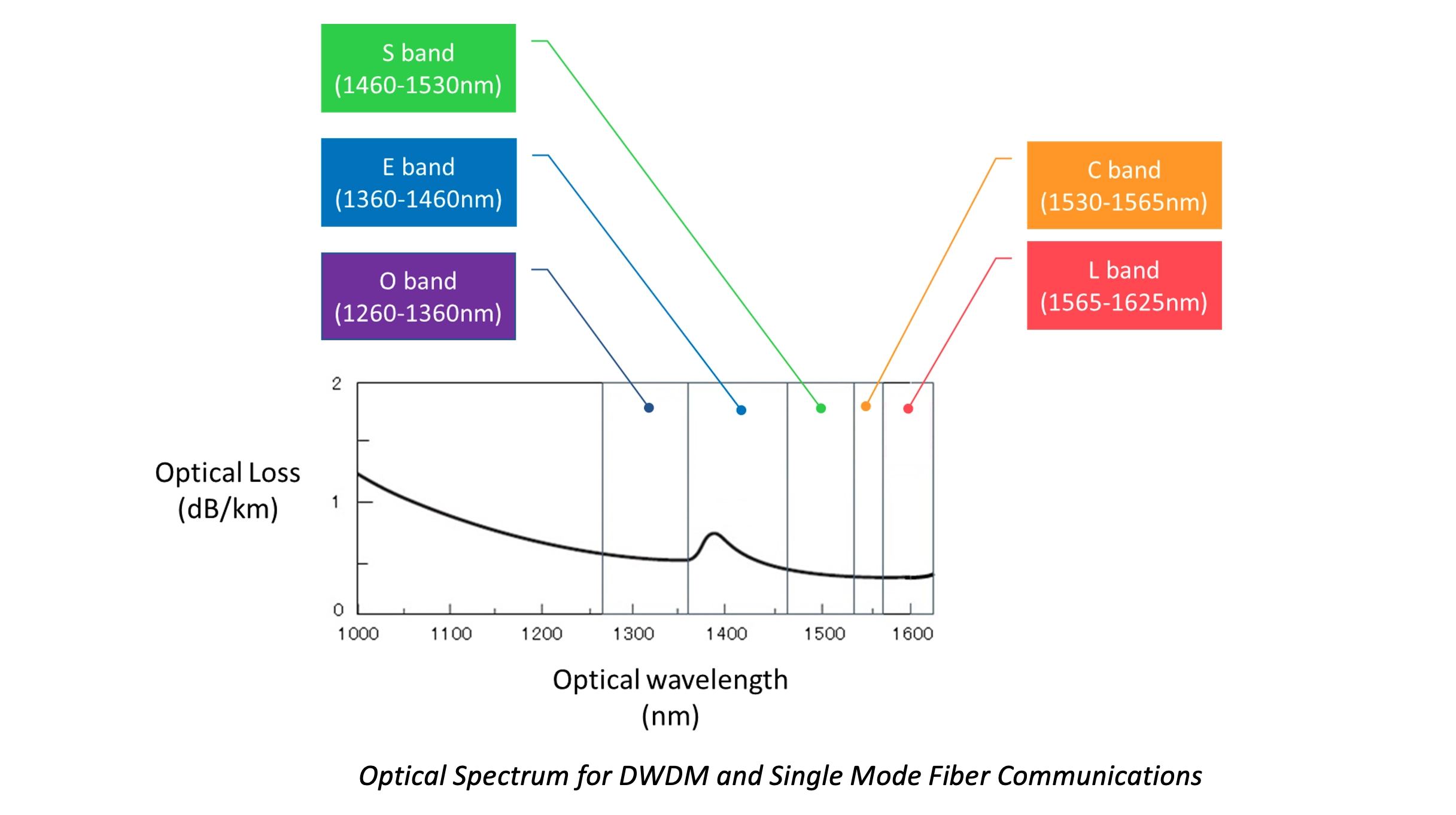Coherent Optics / DWDM
New services and network advancements have driven demand for higher speed connectivity in operator networks.
This has inspired a number of recent innovations to transfer performance and capabilities of optical technologies conceived for core networks and backbones into the access edge.
Zhone has a range of solutions that implement coherent optics and DWDM technology for access network applications, supporting 100 / 200 / 400G capabilities.

Optical Client Interface Technology Progression
The interface speed for packet-based client devices in telecommunications networks have increased over time from 1Gbps and below to 10Gbps and recently to 25Gbps per lane for electrical and baseband optical connections.
Because of physical and technical limitations reaching higher rates for individual channels, higher speed interfaces have been developed that aggregate multiple parallel lanes to increase the total capacity. Examples of ethernet-based network interfaces using this approach include 40G Ethernet – composed of four 10 Gigabit electrical lanes – and 100 Gigabit Ethernet lanes – using four 25 Gigabit electrical lanes.
When implemented as an optical interface, the physical layer of these connections can also use individual channels with independent optical lanes, maintaining the same rate as the electrical lanes. One such approach uses discrete fibers pairs each having their own laser and photodiode for each direction – usually employing a multi-strand optical ribbon cable with an MPO type connector. Examples of transceivers using this technology for Ethernet connections have physical layer designations of 40GBase-SR4 or 100GBase-SR4.
Another similar approach for higher speed interfaces maintains the use of traditional single mode dual fiber infrastructure that is common in telecommunications networks with separate wavelengths for each channel or lane that share the same fiber. This approach is realized through some form of Course Wavelength Division Multiplexing (CWDM) – and is characterized by multiple individual wavelengths that are about 20nm (or about 2.5THz) apart, which then can be combined onto a single fiber facility. An update to this technology – called LAN Wavelength Division Multiplexing (LWDM) – has also been introduced which groups wavelengths around the zero dispersion point of traditional single mode fiber, using the so called “O” band spectrum, simplifying transceiver design and optimizing performance for shorter reach connections. Examples of transceivers using this technology for Ethernet connections have physical layer designations of 40GBase-LR4 or 100GBase-LR4, 100GBase-ER4, etc.
DWDM and Optical Line Interface Innovations
Dense wavelength division multiplexing (DWDM) was originally developed to address the scarcity of fiber facilities for long-haul and backbone networks by maximizing the number of individual channels used on each fiber, and allowing fiber-based amplification techniques that eliminate the optical / electrical conversion steps. The advent of DWDM technology included the establishment of standardized wavelength / channel assignment of the ITU Spectral Grid according to ITU-T Recommendation G.694.1.
Initially, wavelengths in the range of 191.7 THz (1563.86nm) to 196.1 THz (1528.77nm) were used with a fixed channel separation of 100GHz, providing a total of 44 channels for DWDM optical systems in the “C” (or “Conventional”) band. This portion of the optical spectrum is favored due to the minimization of loss from absorption and scattering, to maximize the efficiency and reach of long distance links.
The continuous demand for network capacity has led to the densification of the “C” band spectrum using a narrower, 50GHz channel spacing, offering the option of up to 88 fixed channels in the ordinary band plan. Additionally, extension of the band to use adjacent channels is also possible, including into the “L” (or “Long Wavelength”) band in a higher loss portion of the spectrum between 184.3 THz (1626.67 nm) and 190.0 THz (1577.44 nm).

When combining high capacity channels requiring wider spectral bandwidth, with other channels that tolerate a narrower bandwidth, a fixed grid network approach requires that all channels employ the widest channel spacing used throughout the band plan. This results in potentially inefficient use of spectrum, and unused capacity.
The advent of electronically tunable filters and optical ROADM (Reconfigurable Optical Add Drop Multiplexer) network elements, in combination with transceivers / transponders that are arbitrarily tunable to subgrid channels together create a “flex grid” network capability allowing each channel or carrier to use a variable bandwidth and channel separation.
Synchronous Detection and Coherent Optics
In typical optical fiber communication systems, detection of optical signals are based on a direct measurement of the intensity of the signal – called “Direct Detection” (DD). Similarly, a direct modulation of the signal between an “on” state of intensity, and a lower “off” state is used to encode the information sent by a transmitter – this scheme is referred to as “ Intensity Modulation” (IM). Together, this approach is known as “IM-DD”, a method that has been widely used for optical channels with rates up to and including 25Gbps.
However, for single channel rates at 100G and beyond, these modulation and detection techniques alone are not suitable for useful distances of communication links. The successful detection and recovery of more sophisticated modulations using multiple levels of amplitude, and different phase shifts, in the presence of multiple light polarizations has been made possible with the advent of synchronous detection, also called “coherent optics”
Coherent optics systems use an additional laser oscillator tuned to a specific frequency enabling a principle of optical interferometry to be applied for efficient, sensitive, and low-noise recovery of the optical signals at very low light levels.
New technology has been introduced by Zhone in conjunction with their optical technology partners allowing coherent optics and synchronous detection required for long reach 100, 200 and 400G connections to be made available in access and network edge applications, including in equipment used in outdoor and outside plant applications.
Open Optical Standards
400ZR, Open ZR+, and OpenROADM provide open, interoperable technology for optical systems and networks
400ZR Standard
The 400ZR Implementation Agreement specification created by the Optical Interoperability Forum (OIF) established one of the first open network standards allowing for interoperability of coherent optical systems.
This standard focused on optimizing the technology for transport of packet-based Ethernet payloads, in point-to-point link topologies, including those using unshared “dark” fiber which are all common in metropolitan regional networks, and datacenter interconnect (DCI) applications, among others.
The technical characteristics of the 400ZR interface are support for unamplified, attenuation / loss limited single-wavelength links having a loss budget of up to 20dBm, and amplified, noise limited single wavelength and multi-wavelength DWDM links with 80 to 120km of reach.
Although coherent technology allows for tunable, multiple wavelength operation sharing common fiber facilities, the benefits of reliable operation at high bandwidth with long reach resulting from improved detection sensitivity and dispersion tolerance makes it beneficial even for simple single channel applications.
Open ZR+ Standard
The OpenZR+ Technical Specification created by the Open ZR+ Multi Source Agreement (“Open ZR+ MSA”) group is an alternative to 400ZR which also implements an open, interoperable network standard based on coherent optics offering additional optical performance and service type flexibility supporting a broader range of applications.
Open ZR+ has a multi-rate option, allowing a choice of different modulation formats (QPSK, 8QAM, 16QAM) supporting a choice of selectable 100, 200, 300 or 400G interface speeds. This line side format also supports channelized operation allowing a choice of client payload configurations, with the option of combining multiple packet-based Ethernet clients at 100G or 200G rates into each DWDM channel.
Open Forward Error Correction (oFEC) technology derived from the OpenROADM standards is used in the DSP layer of Open ZR+ compliant devices to increase the effective margin and SNR / loss performance of Open ZR+ interfaces, allowing their use for single spans of at least 80km as well as multiple spans with fiber-based amplification systems for super-regional or long haul applications.
OpenROADM Standard
The OpenROADM Optical Specification created by the Open ROADM Multi-Source Agreement (MSA) group extends the open optical network standard strategy beyond discrete interface characteristics to define a full network level architecture of open, interoperable optical components including a Reconfigurable Add-Drop Multiplexer (ROADM), Inline Amplifier, Regenerator, Muxponder, Transponder, and associated Pluggable Optics transceivers, along with an SDN control system called the OpenROADM Controller supporting the collective network.
Networks implementing the OpenROADM standard need not implement all of the defined components, such as the case where simple point-to-point topologies are used, for example. In this case, only the basic capabilities of the Wavelength-level (“W”) interface provided by transponders are used. Like the simpler Open ZR+ specification, multi-span amplified links are possible, and the oFEC DSP operation is used, so single channel optical performance is comparable.
OpenROADM supports a 100G Ethernet or OTU4 minimum client input for a transponder, which is then adapted into a 100G OTU4 DWDM signal; support for the additional network rates of 200G, 300G, and 400G were also added in subsequent releases of the specification.





